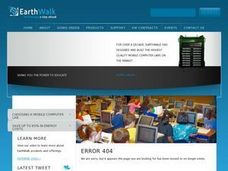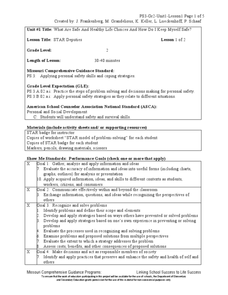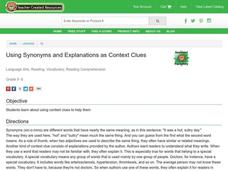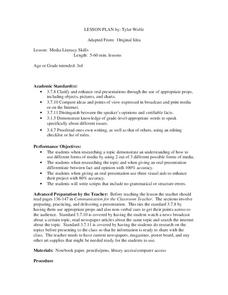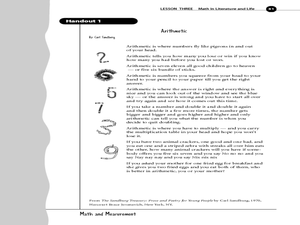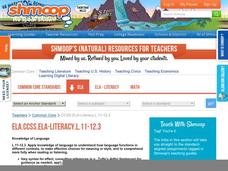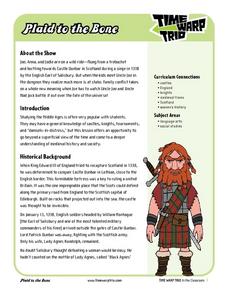Curated OER
Back to School (Secondary)
Welcome your class back to school! They will participate in a character education lesson plan in order to build community at the school. First they identify needs of new students by putting themselves in their shoes and create welcome...
Alabama Learning Exchange
Swim the Open Sea: Analyzing Duel Vectors
This dual vector lesson has the class watch a video about a person's swim of the English Channel. The class then uses a computer program to analyze dual vectors of wind's effect on a flight path of a plane as compared to the water...
Curated OER
Do As I Do
Lead your class in practicing gross motor body movements. Put on some background music and lead them through hops, skips, jumps, leaps, and running in place. Think of animal movements and have them move like an elephant or slither like a...
Curated OER
Fish Tales
Have your class learn about marine life. Learners write a story about a fish, create an art project, and share their work with the class. This experience could be enhanced by having them conduct Internet research to discover some of the...
Curated OER
Grammar Practice: Parallel Structure
Help your young writers improve the clarity of their sentences by showing them how to create parallel structures as they construct sentences. Two exercises give kids practice identifying the correct parallel structure and crafting...
Curated OER
Meet Your New eBuddy
Learners are introduced to the eBuddies laptop system. Using the technology, they create a new Word document and practice using a mouse. Opening a new window from Internet Explorer, they view an appropriate site which allows them to...
Curated OER
Pop Art Pins & Magnets
Students examine cereal and snack boxes and then create magnets and/or pins using the Pop Art demonstrated in these pieces. This multi-level lesson emphasizes the differences between commercial art examples and fine art examples.
Curated OER
Modeling Integer Multiplication
Pupils multiply positive and negative integers. They represent word expressions with both positive and negative integers and then multiply them. They also create multiplication problems to solve as a class. They create a rhyme, a story,...
Curated OER
Paul Revere and Point of View
Students analyze the engraving of Paul Revere to make a judgment about the time period of the Boston Massacre. The objective is that one creates an account of the event from the perspective of a British soldier.
Curated OER
Holidays Around the World
Students explore how different holiday traditions are celebrated around the world. Scholars write a paper describing how they celebrate their own favorite holiday. Email partners, from different states and countries, share their...
Curated OER
STAR Deputies
Second graders engage in a lesson plan that is about the sharing of following rules to follow the law. They concentrate on the making of safe choices. Students use the examples to have class discussion. They also role play scenarios of...
Curated OER
Using Synonyms and Explanations as Context Clues
How can context clues help your young readers understand material better? Focusing on synonyms and explanations as ways to determine word meaning, this activity encourages your class to find context clues within a sentence. An attached...
Curated OER
Media Literacy Skills
You're on camera! Third graders find a news story and research it to get more information. Everyone uses their found information to write a script and create their own news broadcast!
Curated OER
Math in Literature and Life
Pupils read poems, read phrases, and create a poster for what math is and relate it back to literature. They also discuss the impact math has had on literature.
Curated OER
Who are the Greeks?
Who are the Greeks and where did they come from? Answer this and many other interesting questions related to Greek origins. You'll expose your class to the Minoan, Mycenaeans, and Dorians. Then they'll uncover how those three cultures...
Curated OER
The Glory That Was Greece: A Test
Did your class just finish a unit on Greek life, culture, and conquest? If you think they know everything there is to know about Ancient Greece, then put them to the test with this exam, which contains thirty multiple choice questions.
Shmoop
ELA.CCSS.ELA-Literacy.L.11-12.3
Tired of simple sentences? Bored by brief sentences? Plagued by boring sentences? Enrich your life and the writing of your pupils by modeling how to combine sentences to create more varied syntax. Groups then find a number of ways to...
Curated OER
Spanish Reflexive Verbs
Why is it that in English you shave, and in Spanish you shave yourself? Spanish uses reflexive verbs. Your pupils can master reflexive verbs with the explanation provided here. Conjugation of this type of verb is described with...
Curated OER
Fire Alarms for Safety
Students create a fire safety rules poster. In this fire safety instructional activity, students inspect their classroom and discuss the best way to exit in case of a fire. Students then make a poster stating the rules and exit plan.
Curated OER
Civil War
Students explore rules of conduct in a political body, first drafting rules that apply to their classroom, then adapting them to political actions in Congress.
Curated OER
Gender Bender
Students explore the effects of Title IX. In addition, tudents create revised rulebooks for a sport in their school based on their understanding of Title IX and write a related article for the school newspaper.
Curated OER
No Day
Students learn about discrimination and the Jim Crow laws. In this discrimination instructional activity, students are presented with new classroom rules that discriminate against certain types of clothing. Students discuss the effects...
Curated OER
Plaid to the Bone
Students study Lady Anges Randolph and other heroic woman using multimedia. They create class presentations with their findings. They write a diary about living in a medieval castle after researching what life was like in them.
Curated OER
Students as "Grammarians": Discovering Grammatical Rules, Lesson on Reduced Clauses of Reason
In this grammar worksheet, middle schoolers work in pairs to complete the 24 reduced clauses of reason questions. In some questions, students write answers to specific questions, and in some they fill in blanks in sentences.







